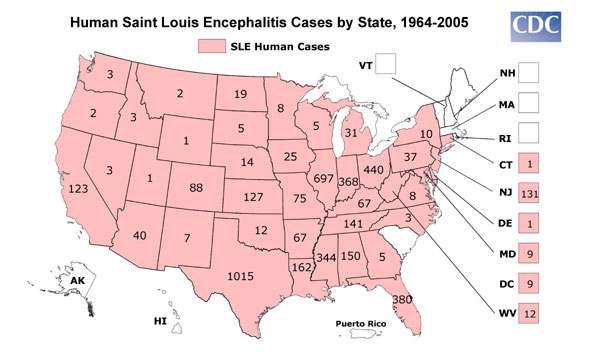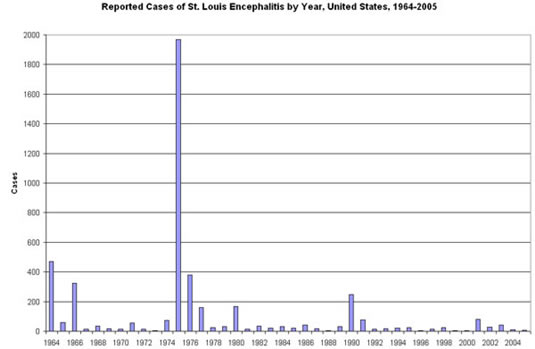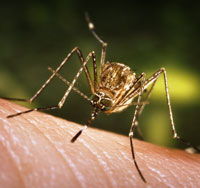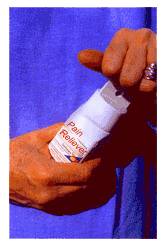St. Louis encephalitis
Please Take Over This Page and Apply to be Editor-In-Chief for this topic: There can be one or more than one Editor-In-Chief. You may also apply to be an Associate Editor-In-Chief of one of the subtopics below. Please mail us [1] to indicate your interest in serving either as an Editor-In-Chief of the entire topic or as an Associate Editor-In-Chief for a subtopic. Please be sure to attach your CV and or biographical sketch.
Overview
St. Louis encephalitis is one of the most common mosquito-transmitted human pathogens in the United States.
References
http://www.cdc.gov/ncidod/dvbid/sle/index.html
Epidemiology and Demographics
St. Louis encephalitis is a viral disease that is spread to humans through the bite of infected mosquitoes. St. Louis encephalitis is found throughout much of the United States, as well as parts of Canada, the Caribbean, and South America.
In the United States, the leading cause of epidemic flaviviral encephalitis is St. Louis encephalitis (SLE) virus. SLE is the most common mosquito-transmitted human pathogen in the U.S. While periodic SLE epidemics have occurred only in the Midwest and southeast, SLE virus is distributed throughout the lower 48 states. Since 1964, there have been 4,437 confirmed cases of SLE with an average of 193 cases per year (range 4 - 1,967). However, less than 1% of SLE viral infections are clinically apparent and the vast majority of infections remain undiagnosed. Illness ranges in severity from a simple febrile headache to meningoencephalitis, with an overall case-fatality ratio of 5-15 %. The disease is generally milder in children than in adults, but in those children who do have disease, there is a high rate of encephalitis. During the summer season, SLE virus is maintained in a mosquito-bird-mosquito cycle, with periodic amplification by peridomestic birds and Culex mosquitoes. In Florida, the principal vector is Cx. nigripalpus, in the Midwest, Cx. pipiens pipiens and Cx. p. quinquefasciatus and in the western United States, Cx. tarsalis and members of the Cx. pipiens complex.


The mortality rate from St. Louis encephalitis ranges from 5 to 30%, with higher rates among the elderly.
References
http://www.cdc.gov/ncidod/dvbid/sle/Sle_FactSheet.html
http://www.cdc.gov/ncidod/dvbid/arbor/arbdet.htm
http://www.cdc.gov/ncidod/dvbid/sle/images/SLE1964_2005.jpg
http://www.cdc.gov/ncidod/dvbid/sle/Sle_ByYear.html
Risk Factors
The elderly are at highest risk for severe disease and death.
References
http://www.cdc.gov/ncidod/dvbid/arbor/arbdet.htm
Pathophysiology & Etiology

St. Louis encephalitis virus is a member of the genus Flavivirus, family Flaviviridae. Other similar diseases are West Nile virus, eastern equine encephalitis, western equine encephalitis, and La Crosse encephalitis.
St. Louis encephalitis virus is transmitted to humans through the bite of an infected mosquito. All residents of and visitors to areas where virus activity has been identified are at risk of getting St. Louis encephalitis, particularly persons living in crowded, low-income areas, and those who engage in outdoor work and recreational activities. St. Louis encephalitis virus infection is thought to confer life-long immunity against re-infection with St. Louis encephalitis virus.
During the summer season, St. Louis encephalitis virus is maintained in a mosquito-bird-mosquito cycle, with periodic amplification by peridomestic birds and Culex species mosquitoes. In Florida, the principal vector is Culex nigripalpus, in the Midwest, Culex pipiens and Culex quinquefasciatus and in the western United States, Culex tarsalis and members of the Culex pipiens complex.
What is the basic St. Louis encephalitis virus transmission cycle?
Mosquitoes (primarily the Culex species) become infected by feeding on birds infected with the St. Louis encephalitis virus. Infected mosquitoes then transmit the St. Louis encephalitis virus to humans and animals during the feeding process. The St. Louis encephalitis virus grows both in the infected mosquito and the infected bird, but does not make either one sick.
What is the incubation period for St. Louis encephalitis?
The incubation period (time from infection to illness) is usually five to 15 days.
References
http://www.cdc.gov/ncidod/dvbid/sle/Sle_FactSheet.html
http://www.cdc.gov/ncidod/dvbid/sle/Sle_Transmission.html
Natural History
St. Louis encephalitis virus is a flavivirus that was first identified in St. Louis, Missouri in 1933.
References
http://www.cdc.gov/ncidod/dvbid/sle/index.html
Diagnosis
Laboratory diagnosis of St. Louis encephalitis virus infection is generally detected through testing (ELISA or MIA or PRNT) of serum or CSF to detect virus-specific IgM and neutralizing antibodies.
In fatal cases, PCR, histopathology with immunohistochemistry, and virus culture of autopsy tissues continue to be useful. Only a few state laboratories or other specialized laboratories, including those at CDC, are capable of doing this specialized testing.
Differential Diagnosis
References
http://www.cdc.gov/ncidod/dvbid/sle/Sle_Diagnosis.html
History and Symptoms
Less than 1% of St. Louis encephalitis viral infections are clinically apparent and the vast majority of infections remain undiagnosed. Illness ranges in severity from a simple febrile headache to meningoencephalitis, with an overall case-fatality ratio of 5 to 15%. The disease is generally milder in children than in adults, but in those children who do have disease, there is a high rate of encephalitis (inflammation of the brain). The elderly are at highest risk for severe disease and death.
References
http://www.cdc.gov/ncidod/dvbid/sle/Sle_Symptoms.html

No vaccine or specific antiviral treatment for St. Louis encephalitis is available. Treatment is based on symptoms. Rest, fluids, and ibuprofen, naproxen, acetaminophen, or paracetamol may relieve symptoms of fever and aching. Aspirin should be avoided. Care of patients depends upon the severity of symptoms and complications.
Pharmacotherapy
References
http://www.cdc.gov/ncidod/dvbid/sle/Sle_FactSheet.html
Primary Prevention
There is no vaccine to prevent St. Louis encephalitis in humans. Reducing exposure to mosquitoes is the best defense against St. Louis encephalitis and other mosquito-borne diseases. There are several approaches you and your family can use to prevent and control mosquito-borne diseases.
Avoid Mosquito Bites
- Use Insect Repellent. On exposed skin when you go outdoors, use an EPA-registered insect repellent such as those with DEET, picaridin or oil of lemon eucalyptus. Even a short time being outdoors can be long enough to get a mosquito bite. *Wear Proper Clothing to Reduce Mosquito Bites. When weather permits, wear long-sleeves, long pants and socks when outdoors. Mosquitoes may bite through thin clothing, so spraying clothes with repellent containing permethrin or another EPA-registered repellent will give extra protection. Do not apply repellents containing permethrin directly to skin. Do not spray repellent on the skin under your clothing.
- Be Aware of Peak Mosquito Hours. The hours from dusk to dawn are peak biting times for many species of mosquitoes. Take extra care to use repellent and protective clothing during evening and early morning or consider avoiding outdoor activities during these times.
Mosquito-Proof Your Home and Community
- Drain Standing Water. Mosquitoes lay their eggs in standing water. Limit the number of places around your home for mosquitoes to breed by getting rid of items that hold water.
- Install or Repair Screens. Some mosquitoes like to come indoors. Keep them outside by having well-fitting screens on both windows and doors. Offer to help neighbors whose screens might be in bad shape.
- Clean Up. Mosquito breeding sites can be anywhere. Neighborhood clean up days can be organized by civic or youth organizations to pick up containers from vacant lots and parks, and to encourage people to keep their yards free of standing water. Mosquitoes do not care about fences, so it is important to control breeding sites throughout the neighborhood.
- Look into Mosquito Control Programs. Check with local health authorities to see if there is an organized mosquito control program in your area. If no program exists, work with your local government officials to establish a program.
References
http://www.cdc.gov/ncidod/dvbid/sle/Sle_Prevention.html
Acknowledgements
The content on this page was first contributed by: C. Michael Gibson, M.S., M.D.